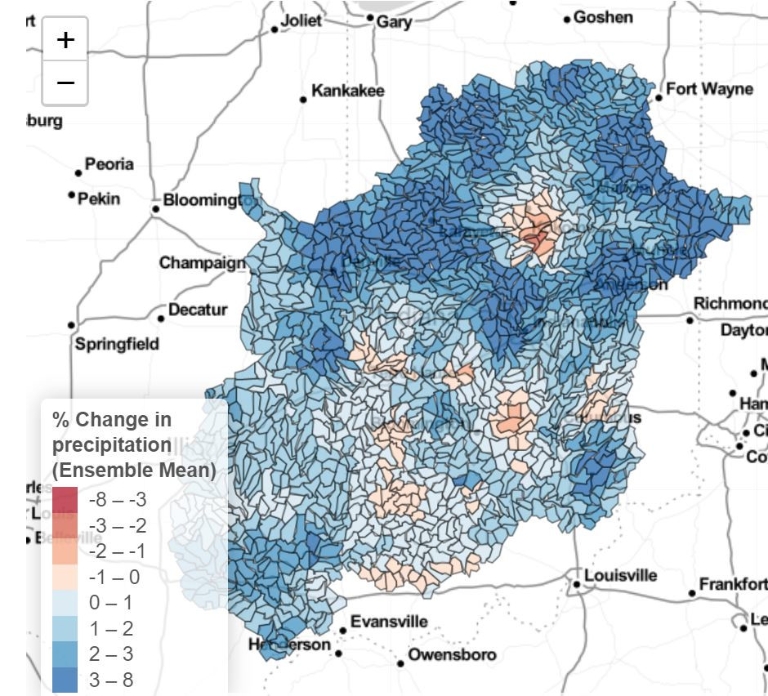To promote collaborative research and inform water stakeholders throughout the state, an Indiana University research team has created the Future Water science gateway, a public interactive data portal that shows users a highly detailed model of the Wabash River Basin under a number of different climate scenarios.
The project is an initiative of IU's Environmental Resilience Institute, part of the Prepared for Environmental Change Grand Challenge initiative, to provide Indiana with accurate predictions that help the state prepare for changes that will affect Hoosiers' health and livelihoods.
Within the science gateway website, users can drill down to view forecasts for smaller-scale watersheds at multiple future time periods and under different global carbon emissions scenarios to see projected changes in precipitation, soil and waterways. Results are available as maps and graphs.

Data are available to download, giving researchers the opportunity to conduct their own analysis, update the existing model or run entirely new models. Beyond water management, Future Water research data could help advance solutions in agriculture, wastewater treatment, land use and species migration, among other applications.
"By making Future Water data publicly available and accessible, we endeavor to change the way that science results are communicated and serve society," said IU professor of earth and atmospheric sciences and Haydn Murray Chair Chen Zhu, who led the project. "We're giving everyone the opportunity to build on our work and address pressing problems in water and land management. Furthermore, in alignment with ERI's mission to prepare Indiana for environmental change, we hope that experts and government leaders in the state will use these data as a resource to plan for the future."
Indiana climate scientists have already projected that the state is likely to experience more hot days, wetter springs and winters, and more extreme rain events as a result of climate change. How these conditions translate to water supplies on the ground, however, is not as well understood.
Using an ensemble of climate models provided by researchers at the University of Notre Dame and applied in the latest Indiana Climate Change Impacts Assessment Report -- along with hydrological modeling software developed by the U.S. Department of Agriculture and datasets encompassing Indiana's elevation, land use, land cover, soil types and streamflow -- Zhu's team developed its regional-scale watershed model on IU's formidable computing infrastructure, including the Big Red series supercomputers. IU dedicated its newest supercomputer, Big Red 200, in January as part of the university's bicentennial celebration. The new system will be able to run updated versions of the team's hydrological models more efficiently than ever, thanks to artificial intelligence capabilities and a peak performance rate of more than 6 petaFLOPS.
To create the science gateway and share its results, the team worked with IU Research Technologies staff. As science becomes increasingly data-driven and collaborative, science gateways are playing a key role in facilitating scientific research.
"It's one challenge to create all the data; it's another challenge to use it," said Marlon Pierce, director of IU's Cyberinfrastructure Integration Research Center. "Creating science gateways like that of Future Water, and with the support of the National Science Foundation-funded Science Gateways Community Institute, makes it easier for researchers to build on one another's work and have a greater impact on society."
With the initial model complete, Zhu's team is collaborating with the U.S. Geological Survey to incorporate projections for Indiana groundwater supplies and nutrient runoff in an updated version of its hydrological model.
"We need an accurate inventory of groundwater supplies in the state and a better assessment of nitrate and arsenic contamination," Zhu said.
Prepared for Environmental Change
The Indiana University Prepared for Environmental Change Grand Challenge initiative brings together a broad, bipartisan coalition of government, business, nonprofit and community leaders to help Indiana better prepare for the challenges that environmental changes bring to our economy, health and livelihood. Announced in May 2017, Prepared for Environmental Change is working to deliver tailored and actionable solutions to communities across the state of Indiana.
IU Research
Indiana University's world-class researchers have driven innovation and creative initiatives that matter for 200 years. From curing testicular cancer to collaborating with NASA to search for life on Mars, IU has earned its reputation as a world-class research institution. Supported by $680 million last year from our partners, IU researchers are building collaborations and uncovering new solutions that improve lives in Indiana and around the globe.






